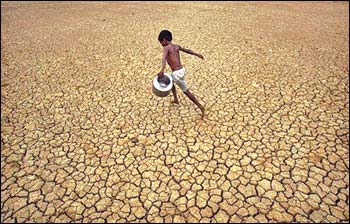|

Huge parts of world are
drying up
Land ‘evapotranspiration’ taking unexpected turn :
“The soils in large areas of the Southern Hemisphere, including major
portions of Australia, Africa and South America, have been drying up in
the past decade, a group of researchers conclude in the first major
study to ever examine “evapotranspiration” on a global basis.

Most climate models have suggested that evapotranspiration, which is
the movement of water from the land to the atmosphere, would increase
with global warming. The new research, published online recently in the
journal Nature, found that is exactly what was happening from 1982 to
the late 1990s. But in 1998, this significant increase in
evapotranspiration — which had been seven millimeters per year — slowed
dramatically or stopped in large portions of the world, soils are now
becoming drier than they used to be, releasing less water and offsetting
some moisture increases elsewhere.
Due to the limited number of decades for which data are available,
scientists say they can’t be sure whether this is a natural variability
or part of a longer-lasting global change. But one possibility is that
on a global level, a limit to the acceleration of the hydrological cycle
on land has already been reached.
If that’s the case, the consequences could be serious.
They could include reduced terrestrial vegetation growth, less carbon
absorption, a loss of the natural cooling mechanism provided by
evapotranspiration, more heating of the land surface, more intense heat
waves and a “feedback loop” that could intensify global warming.
“This is the first time we’ve ever been able to compile observations
such as this for a global analysis,” said Beverly Law, a professor of
global change forest science at Oregon State University.
“We didn’t expect to see this shift in evapotranspiration over such a
large area of the Southern Hemisphere,” Law said. “It is critical to
continue such long-term observations, because until we monitor this for
a longer period of time, we can’t be sure why this is occurring.” Some
of the areas with the most severe drying include southeast Africa, much
of Australia, central India, large parts of South America, and some of
Indonesia. Most of these regions are historically dry, but some are
actually tropical rain forests.
Greater evapotranspiration was expected with global warming, because
of increased evaporation of water from the ocean and more precipitation
overall. And data indeed show that some areas are wetter than they used
to be.
However, other huge areas are now drying out, the study showed. This
could lead to increased drought stress on vegetation and less overall
productivity, Law said, and as a result less carbon absorbed, less
cooling through evapotranspiration, and more frequent or extreme heat
waves.
Evapotranspiration returns about 60 percent of annual precipitation
back to the atmosphere, in the process using more than half of the solar
energy absorbed by land surfaces. This is a key component of the global
climate system, linking the cycling of water with energy and carbon
cycles.
Longer term observations will be needed to determine if these changes
are part of decadal-scale variability or a longer-term shift in global
climate, the researchers said.
-ScienceDaily |

